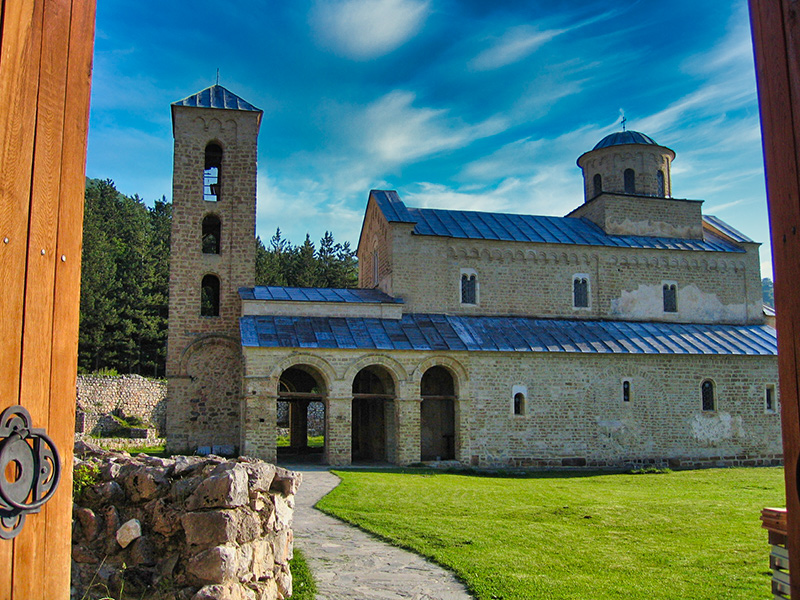Serbian Medieval History
Monastery Sopoćani

BLAGO Collection
The Sopocani Monastery, dedicated to the Holy Trinity, was founded by King Uros I.
The church and the narthex were built in the 1260s. The exonarthex with the bell-tower was added in the first half of the fourteenth century. Several members of the royal family were buried in the monastery, including the King's mother Anne Dandolo, Stefan the First Crowned, Grand Duke George and Uros I himself. Fresco painting of the church was completed in 1270. The exterior part of the narthex was carried out after two reconstructions of the bell-tower, in the time of Dusan. Shortly after the Kosovo battle the monastery suffered serious damages and was restored during the rule of Despot Stefan, when certain alterations were made, especially in fortification. Additional building works also were performed on the central gate, and the tower was erected. In later history, the monastery was seriously damaged several times by the Turks.
The Church is a single nave building with a semicircular apse and a narthex facing west. The nave consists of three bays, the central one being domed. Flanking the narthex, there are two adjoining chapels which are fully separate chambers. The exterior appearance of the church is Romanesque. The portal and the windows are made of stone. The master builders may have come from the Adriatic region.
The earliest frescoes, those in the nave, were created in 1273-4. Due to the large size of the saints' figures, there are relatively few scenes on the walls. The compositions of the Assumption of the All-Holy Virgin and the Festival Cycle stand out. The founders' composition is on the south side of the nave, representing Uros I on the throne awaiting the Virgin who leads Stefan Nemanja, Stefan the First Crowned and Uros I with the church model.
The frescoes in the narthex were painted later. For the first time in Serbian painting the Ecumenical Councils, the story of Joseph, the Last Judgment, and the Jessee Tree were placed in such a part of the church. The composition of the death of Queen Ann Dandolo on the north walls bears special significance: over the catafalque stands her son Uros I with his sons Dragutin and Milutin, as well as the other members of the royal family. Kneeling in front of the catafalque there is the king's wife Queen Helen d'Anjou. The painting is strikingly similar to the composition of the Assumption of the All-Holy Virgin. Along with the cast of the south walls, members of the royal family were painted once more, the King with the Queen and their sons.
The frescoes in the two chapels were painted at a later date. Noteworthy are the representations of the death of Stefan Nemanja in the south chapel, and the transfer of his relics to Studenica. Fragments of the fourteenth-century frescoes have been preserved in the deteriorated added outer narthex, showing portraits of Emperor Dushan and his wife Helen. The Sopocani frescoes are the most eminent examples of European painting at that time. What the painters of Sopocani attained in linearity and coloring have been surpassed only in the Italian renaissance.
Others
More Information
BLAGO Content
While the content of the BLAGO Fund collections is free to use, there are also some restrictions on commercial use and proper attribution of the material. Follow the links below for more information.
> BLAGO Collections License
> Image Request
BLAGO Fund also accepts the contribution of material. Please contact us with any material you wish to publish on our website.
Contact
BLAGO Fund, Inc.
PO Box 60524
Palo Alto, CA 94306
USA
info@blagofund.org

